How it Works
- The Psalms are first divided into pairs of lines, like a responsive reading. (The Psalter in the Book of Common Prayer, for example, has been in this format for hundreds of years.)
- Each line is then marked for singing in rhythm with two main parts:
- A main section sung on one note, which may be long or short depending on the text
- The ending, to be sung using three notes
- Tunes are written in various moods where each line matches this pattern—a main note, followed by three ending notes.
- Tunes are written in various moods where each line matches this pattern—a main note, followed by three ending notes.
Any Psalm marked in this way may be sung using any tune written in this pattern.
You do not need to be able to read music to sing Rhythmic Psalms. Once you learn to read the rhythms of the Rhythmic Psalms text, it is easy to follow along. Or you may simply speak them as rhythmic poems! Audio examples are posted at RhythmicPsalms.com. For those who do read music, musical notation and chords are provided below.
Learn the Markup
Every syllable is sung evenly unless there is special markup. Say (or sing on one note) this string of numbers evenly, two per beat. The dots below the line are each a beat, or a “toe tap.”

Main Note and Ending Notes
Each line of a Rhythmic Psalm has a Main Note and three Ending Notes.
- The Main Note may be short or long, depending on the text. Words are sung two syllables per beat unless otherwise marked.
- The three Ending Notes always start on a beat. The last note may have one syllable or two.
Accent
An accent ( ` ) marks the first full beat of the Main Note. (You’ll see why this is needed soon.)
Slash
A slash ( / ) marks the beginning of the Ending Notes. It is always on a beat.
Here’s the example from above adding an Accent and a Slash.

You could sing it like this:

I sincerely hope that some gifted singers will be inspired to take up Rhythmic Psalms soon. In the meantime, my voice will have to do. —Doug
Underscore
An underscore ( _ ) marks a note held for a full beat in the Main Note phrase.
In this example, the one-syllable word “three” is held for a full beat, and the Ending Notes start on the beat right after that:

You could sing it like this:

Ending Notes with Four Syllables
The last ending note may also have two syllables. Here’s an example:

You could sing it like this:

Tilde
A tilde ( ~ ) marks a syllable held for a full beat over the first two Ending Notes. Here’s an example:

You could sing it like this:

Pickup Note
A line may have one Pickup Note before the first full beat of the Main Note (the Accent) to help the phrase sound more natural. In this example the first full beat (the “toe tap”) is on the second syllable of the word “eleven.”

You could sing it like this:

Rhythmic Psalm Tunes
As noted above, any psalm marked up as a Rhythmic Psalm may be sung to any Rhythmic Psalm tune. When written out, the tunes show only the sequence of notes—the Main Note and the three Ending Notes. Each chord represents a new line.
The actual length of the Main Note varies according to the text of the psalm, of course. Extra beats for the beginning and ending of lines are also not shown.
The following examples will use a tune inspired by Psalm 130. Here is the main part of that tune.

Example: Psalm 6
I chose the first two stanzas of Psalm 6 as an example because they have short lines, simple markup, and show all of the features presented so far.
The first two lines of the first stanza have no special markup. All of the syllables are sung evenly. Notice that the last Ending Note of the first line has two syllables.
The third line starts with a Pickup Note, and the last line has an Underscore (a note held for a full beat).
Psalm 6, Stanza 1
`LORD, do not rebuke me / in your anger,
`neither discipline me / in your wrath.
Have `mercy on me, LORD, for / I am faint.
`LORD_, heal me, for my / bones are troubled.
You could sing this stanza like this:

The next four-line stanza starts with a Pickup Note on every line. The second line has a Tilde, so that syllable is held for a full beat over the first two Ending Notes.
Psalm 6, Stanza 2
My `soul is also / in great anguish.
But `you, LORD / how~ long?
Re `turn_, LORD. De / liver me,
and `save me for your loving / kindness’ sake.
You could sing the second stanza like this:
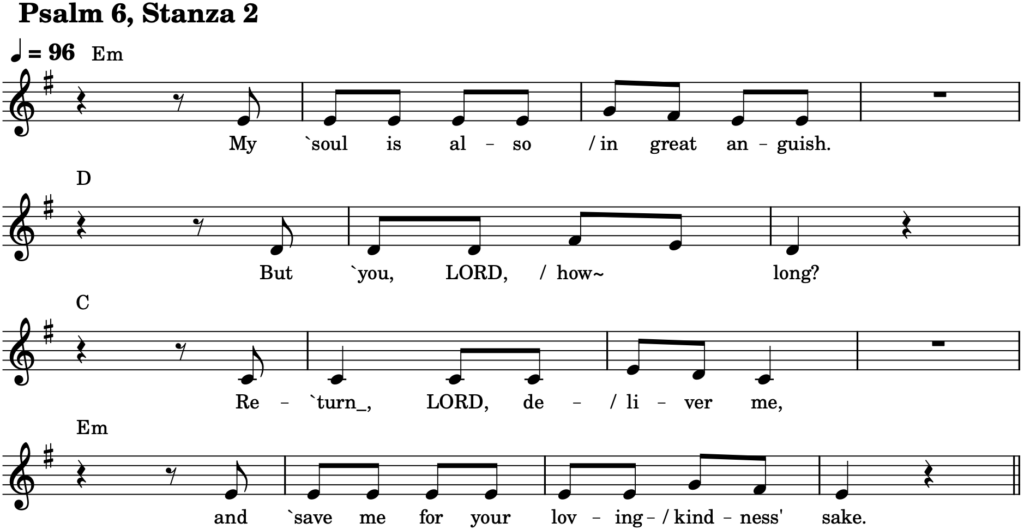
Special Variations
The Plus Sign for Six-Line Stanzas
The default stanza length for Rhythmic Psalms is four lines. Sometimes, however, there are six lines that belong together in meaning, or a psalm cannot be divided into four-line stanzas. In those cases there is a Plus Sign ( + ) at the end of the fourth line, followed by lines five and six.
Lines five and six are sung using the last two lines of the tune just above it—that is, the second half of the tune that you just finished. Here is an example from the beginning of Psalm 25.
Psalm 25, Stanza 1
In `you_, LORD, I / put my trust.
My `God_, I have trusted / in~ you.
Do `not let me be / put to shame.
`Do not let my enemies_ triumph / over me. +
In `deed, no one who waits for you_ will be / put to shame.
`They will be shamed who deal treacherously / without cause.
You could sing this stanza like this:
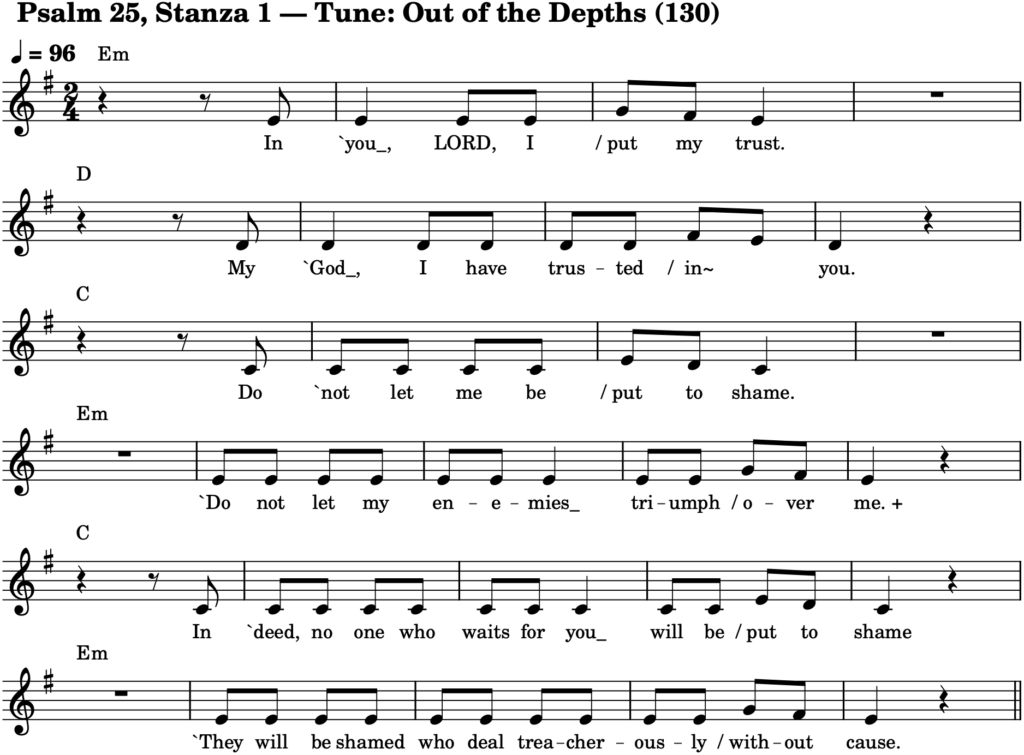
Bullets for Double Endings
If a line is very long it may have a Double Ending. A Double Ending stays on the same line of the tune, starting over after the first set of Ending Notes. It is marked by one or two Bullets ( • ), each of which is a beat, or a “toe tap,” of rest.
Double endings are never required, since there is no limit on the length of the Main Note. They can, however, make long lines easier to sing. They are especially appropriate when there are two distinct phrases in a long line.
The next stanza of Psalm 25 has a double ending in the last line.
Psalm 25, Stanza 2
`Show_ me your / ways~, LORD.
`Teach_ / me your paths.
`Guide me in your truth, and / teach~ me,
`for you are the God of / my salvation. • I `wait for you_ / all day long.
You could sing the second stanza like this:
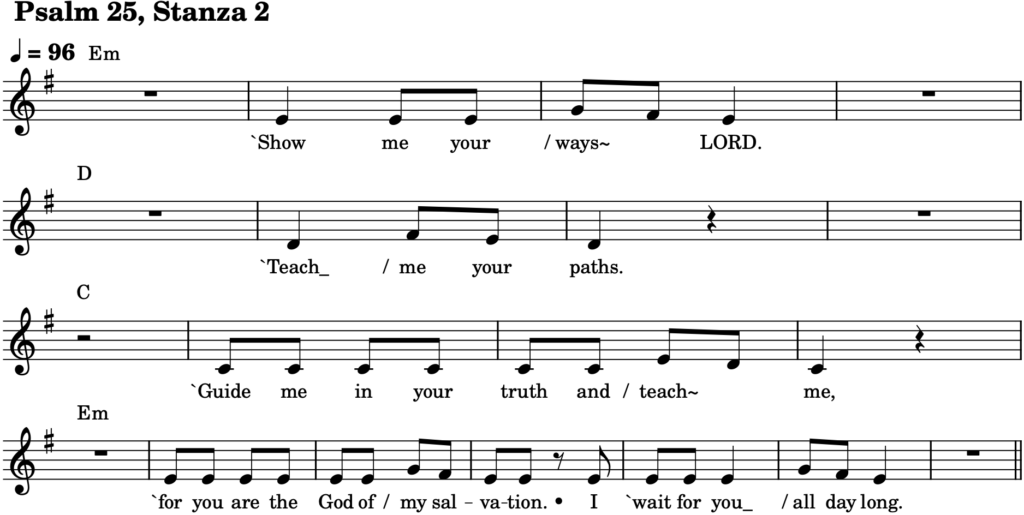
Those are all of the markings you need to know to sing all of the Rhythmic Psalms!
Example: Psalm 23
The Markup
Psalm 23
The `LORD_ / is my shepherd;
`I shall / lack~ nothing.
He `makes me lie_ down in green_ / pas~ tures.
He `leads_ me beside_ still_ / wa~ ters.
`He re / stores my soul.
He `guides me in the paths of righteousness for / his name’s sake.
`Even though I walk_ through the valley of the shadow / of~ death,
`I will / fear no evil,
(Ref)
for `you are / with~ me.
Your `rod_ and your staff, they / comfort me.
`You prepare a ta_ ble before me in the presence of my / enemies.
`You anoint my / head with oil. • • My `cup_ / runs~ over.
`Surely goodness and_ / loving kindness
shall `follow me_ all the days_ / of my life,
`and_ / I will dwell
`in the house_ of the LORD for / e~ ver.
The Tune
This tune is inspired by Psalm 19. It includes an optional Refrain, discussed here. (Remember that other tunes could be used instead of this one.)

Arrangements for Group Singing and Personal Prayer
Below are two arrangements that show the flexibility of Rhythmic Psalms. Details and standards used are presented in the next chapter.
Group Singing Arrangement
This arrangement adds a little time to prepare for each line, helping people sing together.
Psalm 23 – Group Singing Arrangement
The Heavens Declare (19)

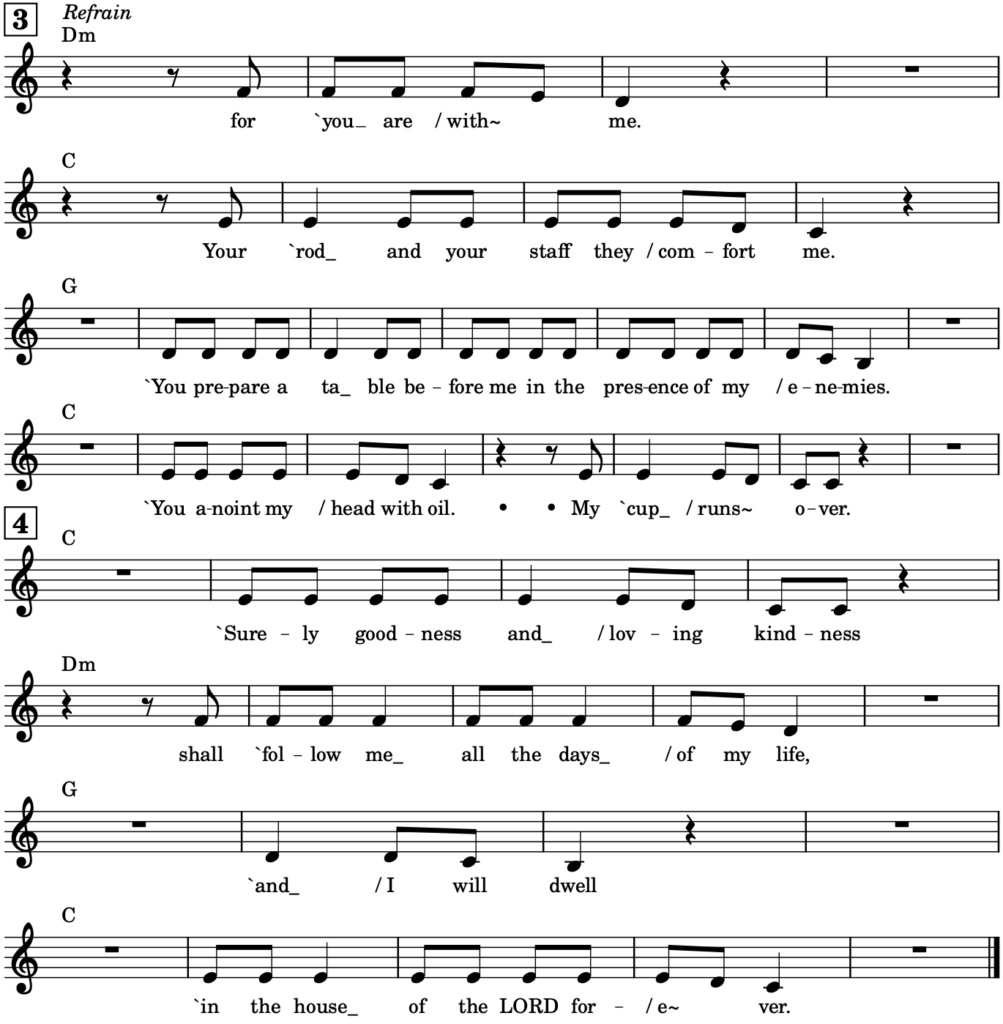
Personal Prayer Arrangement
In personal prayer, I am usually not using an instrument. The rhythm and tempo can be more fluid than when singing with others. You can pause after any stanza as needed.
Psalm 23 – Personal Prayer Arrangement
The Heavens Declare (19)
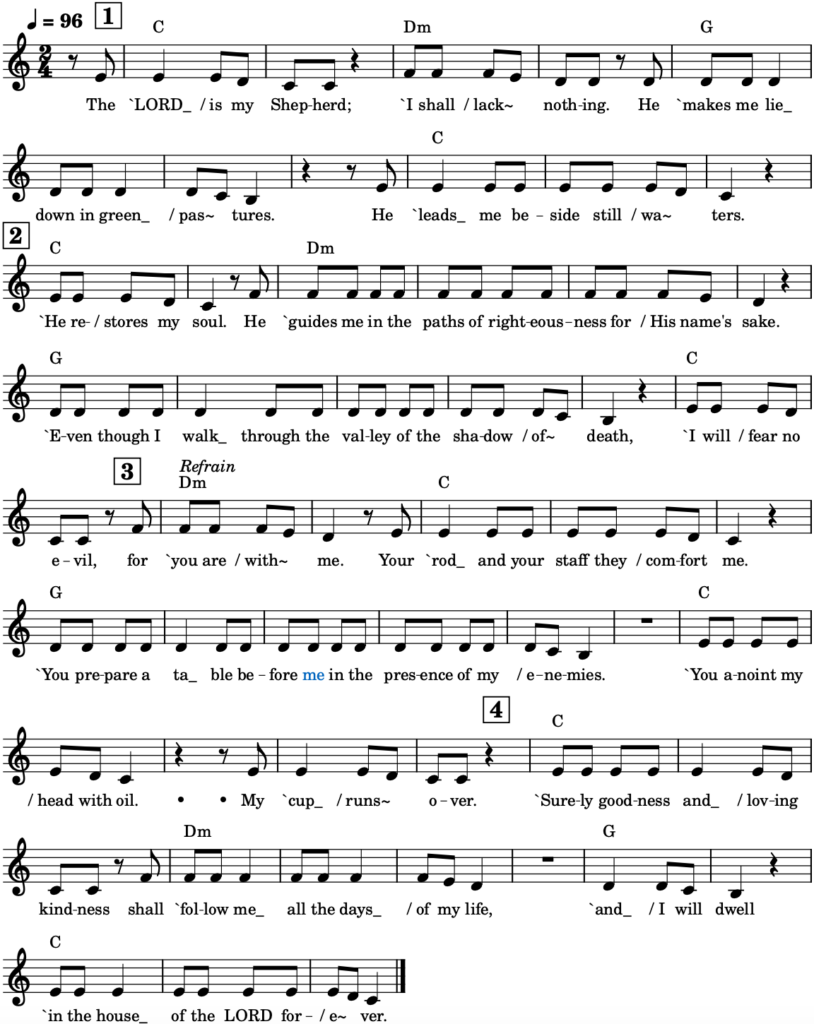
[▶︎ Audio coming soon]

